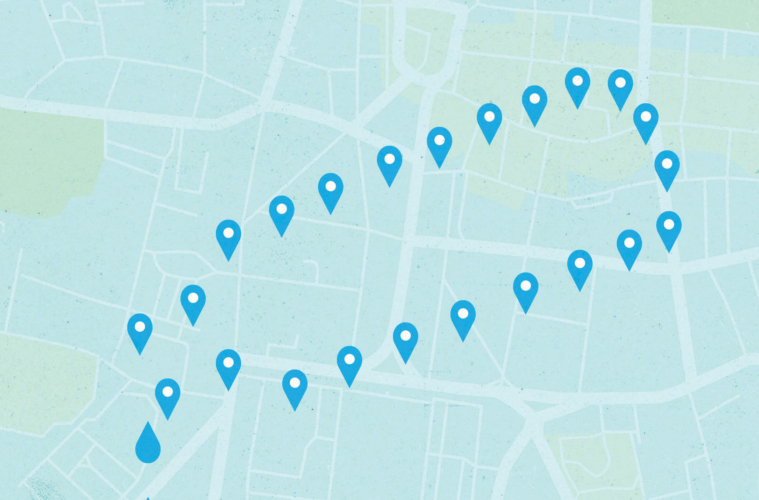A new book co-written by Samantha Zuhlke ’10 and former Colgate professor Manuel Teodoro explores Americans’ strange relationship with drinking water.
The majority of Americans have a treasure in their kitchens — clean, fresh-tasting tap water available for a pittance at the twist of the tap. Yet, a large percentage of Americans turn their nose up at this resource, spending money on bottled water instead.
“Most people have clean, safe water that’s fractions of pennies for the gallon,” asserts Samantha Zuhlke ’10, an assistant professor at the University of Iowa’s School of Planning and Public Affairs, “and yet people believe commercial water is superior — when it’s not held to the same standards as tap.” Tap water quality is stringently regulated by the Environmental Protection Agency, while bottled water is less tightly regulated by the Food and Drug Administration.
Zuhlke examines this paradox in a new book, The Profits of Distrust, co-written with Manuel Teodoro — a former Colgate professor who is now at the University of Wisconsin-Madison — and the University of Missouri’s David Switzer. Comparing public and commercial water consumption across the country, they’ve come to the conclusion that it’s not the quality of tap water that drives consumers away, it’s a loss of trust in government, which commercial water companies benefit from and, in some cases, actively exploit. “People think their tap water is bad, so they defensively buy this more expensive commercial product. That exit to the private sector ultimately reduces the government’s incentive to improve basic services,” Zuhlke says. “It becomes a vicious circle.”
At Colgate, Zuhlke became interested in the social side of environmental issues and decided to major in geography. As a political science minor, she was a research assistant for Teodoro, who taught her how to use maps to bring the political side of environmental issues alive. “So much of conveying a successful argument is about visualizing impact,” she says. “If a picture is worth 1,000 words, a map is worth 10,000.” After graduating, she worked for a few years in geography education at the National Geographic Society before following Teodoro to Texas A&M University, where he asked her to look into the phenomenon of commercial water kiosks in nearby Houston. Practically unknown in the Northeast, the kiosks are everywhere in the southern states; people pay to fill bottles with water that is supposedly filtered, but in reality, it’s even less regulated than bottled water.
As Zuhlke began mapping out kiosk locations throughout the country, she found that they were not in high-income areas where one might expect residents to be able to afford spending more money for water, but in poorer areas with high percentages of racial and ethnic minorities — for example, in Hispanic neighborhoods in Texas or rural African American communities in North Carolina. “Clearly there is a racial and ethnic dimension to this story,” she says. Those neighborhoods were the same places typically marginalized by government, where citizens grow skeptical of its willingness to provide basic services. Zuhlke and Teodoro began to conceive of a book that would use water as a lens to look more broadly at citizens’ relationship to government.
“There is a crisis in trust in government right now in the U.S., and water was an entry point for us to look at that,” she says. “Drinking water is one of the most basic services government provides, and it’s critical to sustaining life. But if you don’t trust the government, you aren’t going to drink the water.” Using data analysis, the authors found that not only did commercial water consumption increase as overall trust in government decreased, but also that those increases occurred more steeply in areas where voter participation was lowest. Moreover, in tracking locations of water kiosks across the U.S. using Google Maps, Zuhlke found high numbers of kiosks in neighborhoods that were “redlined” against housing lending in the mid-20th century, where citizens would be right to be skeptical of the government’s investment in their communities.
When municipal water failures did occur — for example, with lead contamination in Flint, Mich., the researchers found that it led not only to higher private water consumption in that community, but also in other communities that were demographically similar. “It’s not just whether my own tap water is safe to drink, but also whether the government is providing safe drinking water to people who look like me,” Zuhlke says. In some cases, they found, commercial water companies were actively using that phenomenon to increase their profits, for example, running ads with Hispanic mothers and children and pictures of rusty pipes. “Companies understand people are nervous about their water, and they take advantage of that to reap these profits of distrust,” Zuhlke says.
Thankfully, the message of water isn’t all doom and gloom. In several case studies, Zuhlke and her co-authors show how some cities invested in municipal water systems and reversed the trend to create a virtuous cycle, leading to declines in commercial water purchases, better tap water, and more civic engagement overall. Unlike some political problems, she adds, cities know how to improve water supplies with the right investment. When citizens demand improvements in the most basic service of water, it can lead to other improvements as well. “Reaching out and asking the local government to provide tap water that is excellent can make a big difference,” she says. “I hope our book helps people feel more optimistic about how we could reignite civic life in the U.S., by thinking about the basic services you receive and asking for those services to be improved.”

